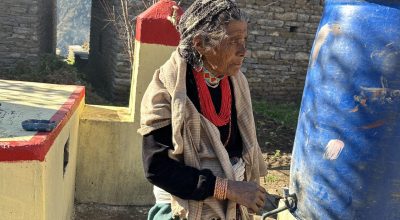
BOOK REVIEW
Yubaraj Nayanghare is a well-known Nepali essayist, with particular thrust in travel essays. He already has over a dozen works to his credit and has not only won several prestigious awards including the Madan Puraskar in 2065 BS but also the hearts and minds of numerous readers at home and abroad.
Tanakkha is a collection of 21 essays that centres around Nayaghare’s three-week travel to Myanmar nearly two years ago and presents his impressions of the Nepali community residing in the South-East Asian nation for generations. The central thread behind the essays is the way Nepalis there love the language and culture of their predecessors although they have no idea which part of Nepal they migrated from, nor have they travelled back to the land of the forebears. It also shows us how they have integrated into their country of residence and how their lifestyle has been changing over time.
Through the essays, we come to know that the Nepalis living in Myanmar have formed All Myanmar Gorhka Hindhu Sangh which has 35 branches and 200 sub-branches all across the country. Besides doing many other things, this organization has been running pathshalas and imparting Nepali language and culture to the children. And a large number of Nepalis graduate from these institutions but the proficiency they acquire is not officially recognized by the Myanmar government. The essayist wonders why the Nepali Embassy in Myanmar and the government back home does not take a step to resolve this issue. The Nepali community has built scores or even hundreds of temples all across the country. And the writer comes across the pictures of Sagarmatha, Buddha and Pashupatinath all around.
Since the Gorkha soldiers played a vital role to secure Burma’s sovereignty in the battle against Japan, the Burmese government gave special recognition to their contribution. The Hindu Gorkhas are quite loyal to the Buddhist government in the country of numerous monasteries and stupas, though they were often caught in a conflict between the government and the local rebels. Only recently the insurgents laid their arms to the respite of the Nepali community.
Most of us know that the army has held strong sway over Myanmar, previously called Burma after a community that ruled the country for long. The essays describe Burmese people as very kind who set aside 3 per cent of their income for charities. The funds collected thus go to build the monasteries and stupas which give a unique identity to the country. We also come to know that Burmese people give high regard to their guests, as do Nepalis.
In the early days of their settlements in Burma, Nepalis were mainly engaged in animal husbandry, and they are gradually taking to agriculture or businesses. But in recent years, Chinese have greater sway over subsistence agriculture as well as businesses as they can invest more money while Myanmar offers a large expanse of fertile land and cheap labour. So the commercial Chinese farms that apply modern technologies are marginalizing many Nepalis from their means of livelihood. Some locals maintain that the Chinese have an undue influence over their way of life. Amid these developments, in some Nepali communities as many as 90 per cent youths are forced to leave the country for employment in neighbouring Thailand, like the youth back home migrate to the Gulf countries or Malaysia for jobs. The older generations, however, don’t quite approve of the youth exodus to the cities or foreign countries giving up their traditional lifestyle. Another development the elderly rue is Nepali girls getting married to Burmese, Indian and even Chinese men which they think will jeopardise their culture in the long run. In contrast, some Nepalis have taken to the business of precious stones and gems, one of the brisk businesses in Myanmar. And Nayaghare says that they are doing quite well.
Nayaghare’s book stands out among many publications that are made every year as it is written in splendid prose that offers images of things being talked about. He takes the readers in the journey up the hills and down the valleys of Myanmar dotted with gleaming monasteries and guides them along and across the imposing Irrawaddy River and the lush green forest. He also creates lifelike pictures of the young and old men and women he comes across in course of his travel to different parts of the country. All in all, Tanakkha has a lot to offer to anyone wishing to know how Nepalis are doing in modern-day Myanmar. But the repeated use of the word ‘aaimai’ instead of more politically correct ‘mahila’ to refer to women which some readers may find objectionable. Obviously, there are some typos, but they don’t devalue the worth the book holds.
















